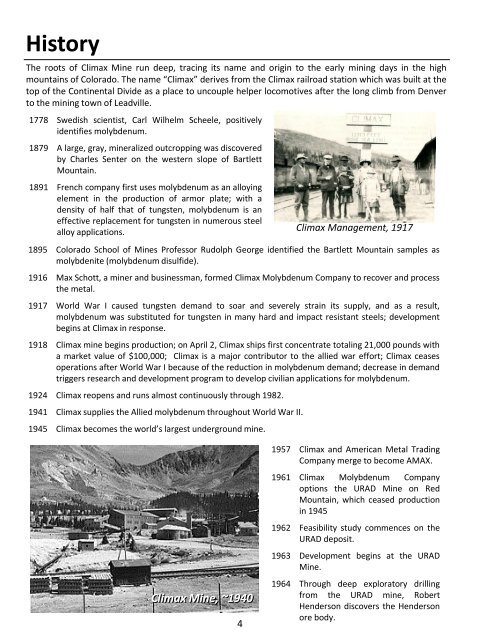Climax Mine - Leadville Today
Climax Mine - Leadville Today
Climax Mine - Leadville Today
You also want an ePaper? Increase the reach of your titles
YUMPU automatically turns print PDFs into web optimized ePapers that Google loves.
HistoryThe roots of <strong>Climax</strong> <strong>Mine</strong> run deep, tracing its name and origin to the early mining days in the highmountains of Colorado. The name “<strong>Climax</strong>” derives from the <strong>Climax</strong> railroad station which was built at thetop of the Continental Divide as a place to uncouple helper locomotives after the long climb from Denverto the mining town of <strong>Leadville</strong>.1778 Swedish scientist, Carl Wilhelm Scheele, positivelyidentifies molybdenum.1879 A large, gray, mineralized outcropping was discoveredby Charles Senter on the western slope of BartlettMountain.1891 French company first uses molybdenum as an alloyingelement in the production of armor plate; with adensity of half that of tungsten, molybdenum is aneffective replacement for tungsten in numerous steelalloy applications.1895 Colorado School of <strong>Mine</strong>s Professor Rudolph George identified the Bartlett Mountain samples asmolybdenite (molybdenum disulfide).1916 Max Schott, a miner and businessman, formed <strong>Climax</strong> Molybdenum Company to recover and processthe metal.1917 World War I caused tungsten demand to soar and severely strain its supply, and as a result,molybdenum was substituted for tungsten in many hard and impact resistant steels; developmentbegins at <strong>Climax</strong> in response.1918 <strong>Climax</strong> mine begins production; on April 2, <strong>Climax</strong> ships first concentrate totaling 21,000 pounds witha market value of $100,000; <strong>Climax</strong> is a major contributor to the allied war effort; <strong>Climax</strong> ceasesoperations after World War I because of the reduction in molybdenum demand; decrease in demandtriggers research and development program to develop civilian applications for molybdenum.1924 <strong>Climax</strong> reopens and runs almost continuously through 1982.1941 <strong>Climax</strong> supplies the Allied molybdenum throughout World War II.1945 <strong>Climax</strong> becomes the world’s largest underground mine.<strong>Climax</strong> Management, 1917<strong>Climax</strong> <strong>Mine</strong>, ~194041957 <strong>Climax</strong> and American Metal TradingCompany merge to become AMAX.1961 <strong>Climax</strong> Molybdenum Companyoptions the URAD <strong>Mine</strong> on RedMountain, which ceased productionin 19451962 Feasibility study commences on theURAD deposit.1963 Development begins at the URAD<strong>Mine</strong>.1964 Through deep exploratory drillingfrom the URAD mine, RobertHenderson discovers the Hendersonore body.


